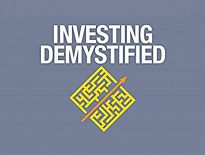Investing Demystified 2 – Assets

Today’s post is our second visit to a book that is popular with passive investors in the UK – Lars Kroijer’s Investing Demystified.
Lars Kroijer
Lars Kroijer’s book is increasingly popular on the UK finance subreddits.
- He has an economics degree from Harvard, and an MBA from the business school there.
Until 2008, Lars was a hedge fund manager.
- He now works at Alliedcrowds.com, which “aggregates alternative capital into the world’s lower-income countries”.
Investing Demystified
I am not a 100% passive investor.
- Lars is, and he pushes what I would call a “Lazy Portfolio” of only two funds.
These are are sub-optimal, particularly for investors with larger portfolios.
I see the appeal of lazy portfolios to novice investors.
- But that’s not the same as saying they are the best option.
Here’s a recap of what we covered last time:
Lars thinks that markets are quite efficient, and the majority of people are not able to outperform them.
- Market-cap weighted indices are by definition averages, and 50% of market participants should beat them (before costs).
They are also inappropriate as benchmarks for private investors.
- You need your own benchmark that reflects the likely composition of your portfolio, and this won’t be 100% stocks.
Market cap weighting is a poor way to construct an index, or to weight a portfolio.
- Equal weighting is better, and volatility parity is even better.
- This applies across assets and geographies as well as within a single stock market.
Truly efficient markets would not exhibit simple outperformance factors like momentum, value, small size, low volatility and quality.
Volatility parity portfolios with factor and trend-following overlays will outperform on a risk-adjusted basis.
Lars thinks that we need only two assets – stocks and bonds.
- I think there are many alternative assets that can add value to a portfolio.
Minimal risk assets
Lars recommends UK government bonds for UK investors.
- Last time out he wanted to match bond duration to investor time horizon.
- But in Chapter 4 he initially picks “short-term” UK government bonds.
Lars spends a bit of time explaining how bonds work.
- He covers credit ratings, and the agencies.
By his own admission:
Credit agencies were widely discredited [sic] after 2008 when they wrongly gave high ratings to all sorts of subprime garbage.
Since Lars doesn’t plan to exclude government bonds not rated at AAA (currently including those from the US, Japan and France) I’m not sure why he spends time on credit ratings.
If you live in a country without a stable currency and / or low-risk government bones, then US bonds are probably your best bet.
- That’s because of the dollar’s role as the global reserve currency.
Lars is not against a mix of high-quality international government bonds as the low risk asset.
Later in the chapter, Lars reverts to matching bond maturities to the investors time horizon.
- He also allows for the addition of index-linked bonds to retirement portfolios.
Risk asset
Chapter 5 is about the risk (and return) asset – global equities.
Lars restates his commitment to global cap-weighted equities, and against home bias.
- As previously discussed, I disagree with both of these points.
Lars claims that over- and under-weighting markets relative to their capitalisation implies a view on their current valuation.
- For me it doesn’t – I’m simply taking advantage of correlations that are less than 1 to improve the risk-adjusted returns of the portfolio.
Lars is also a fan of diversification, but he believes that the world equity portfolio is the most diversified equity portfolio that you can hold.
In the next section, Lars explicitly rules out allocations to small companies and to value stocks.
- He doesn’t mention momentum, low vol or any of the other known outperformance factors.
His logic is that investors who allocate to the opposite strategies (large cap, and growth for example) are just as well informed.
- I would argue that this is clearly not the case, since factors do outperform.
Lars also objects to the idea that the future will be like the past (which is the way many factor funds are built).
- I would say that it’s the best data we have, and what is the alternative? To assume that the future will not be like the past?
Lars also addresses “Away Bias” in this chapter.
- He argues that the US overweight is offset by the international nature of the earnings of the largest US companies.
He notes that international diversification automatically provides FX diversification (protection against the devaluation of your home currency).
- But of course this can go too far.
If the UK is say 5% of global markets, and you therefore have 95% of your portfolio in foreign currencies, a rise in the pound will have a significant impact on the value of your portfolio.
Returns
In the next section, Lars looks at the returns that you might expect from equities, and plumps for 4% to 5% real (after inflation).
- Historically, this looks reasonable – 5% real was the average global return for stocks from 1900 to 2015.
But we are now at the end of a 30-year bond bull market, and interest rates are at historical lows.
- I’ll settle for 3.25% pa real – which my safe withdrawal rate.
Risks
In Chapter 6, Lars looks at risk.
- World equity markets have a standard deviation (volatility of returns) of around 20% pa (up or down from the average return of 5% pa real).
He also notes the great losses that are possible in stock markets, with two falls by more than 50% in the Dow since 1900, and another 6 falls between 40% and 50%.
- Recovery times for buy and hold range from 25 years for the 1929 crash to four years for the 2000 dot com bubble and the 2008 crisis.
Of course, the Japanese market hasn’t yet recovered from the 1990s crash.
- Lars reiterates the importance of diversification, though he points out that it works least when you need it the most (correlations increase during crashes).
Conclusions
That’s it for today.
- We’ve now covered six of the book’s fifteen chapters.
Once again there wasn’t much we could agree on:
- Lars approach to bonds was somewhat more flexible today.
- But he likes cap-weighting, and doesn’t believe in equity outperformance factors.
- We basically agree about returns and their volatility.
In the next article we’ll look at other types of bonds, at “non-portfolio” assets (what I call non-listed assets) and at the assets Lars doesn’t include in his “rational portfolio” (which I would style a lazy portfolio).
- Until next time.















